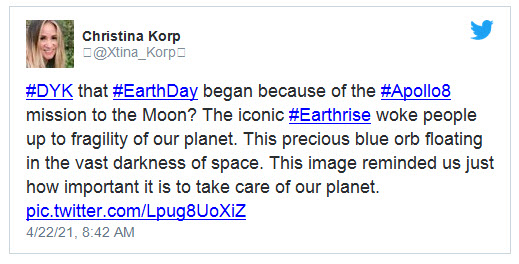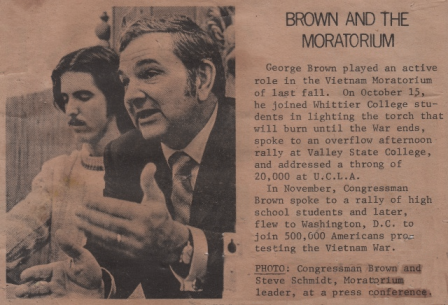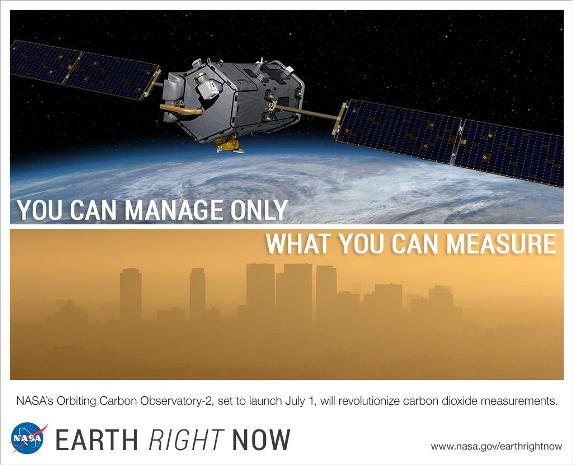File:Christina Korp Earth Day and Apollo 8.jpg
Christina_Korp_Earth_Day_and_Apollo_8.jpg (519 × 264 pixels, file size: 80 KB, MIME type: image/jpeg)
DYK? Yes we do, we remember!
Steve Schmidt (SJS) / Our eyes opened wide in December 1968, Apollo 8's 'Earthrise', and then 1969 pro--peace Earth work and then our first Earth Day in 1970!
Beginnings of the Modern Environmental Movement
Earthrise
First Earth Day Memories
How Your GreenPolicy360 Founder turned political with a Congressman's assist
Environmental Protection and Preservation of Life on Earth
SJS / GreenPolicy Siterunner: Congressman George E. Brown was the man who convinced me to look at politics as a serious calling. When I was a young teenager in East LA, looking out at a larger world in which I had yet to travel, and debating "nuclear weapons proliferation" as the debate topic of the year we were considering and with sirens on occasion loudly going off and forcing us to crawl under our desks, the man I got to know in Monterey Park was at the beginning of his career in politics and science.
For the next 35 years he was my mentor and an inspiration of what can be done to make a difference and create a better world. George was a visionary with tousled hair, a professorial look, a smelly pipe and a twinkle in his eye. He was always there for his constituents, like me, an East LA kid who grew up to be a friend and cohort as we did green work over the years.
George was a real presence in Congress, in science and environmental achievements, from the first Earth Day to the first federal program to study climate science, from the first earth science research from space to 'big science' projects that carry on to this day.
Back in the early days, we would speak of these political efforts, and especially the immediate reality of the 'smog' in LA, which might have been at that time the worst in the world, and how we needed to clean up the air. I spoke of my asthma with George and his engineering background provided his perspective with advantages over the run-of-the-mill politicians in DC in knowing how to best address the pollution from cars, the gas engines that were becoming ubiquitous in fast-growing suburban Southern California.
When your GreenPolicy360 siterunner was in college at USC in the late 1960s and becoming deeply involved in politics, George and I continued to speak of the children in Los Angeles and their lung problems and scientific and medical studies that were vividly (shockingly) demonstrating the consequences of growing up in the most polluted air in the country.
George helped my organizing work and I helped his especially in the "decade of the environment" following the first Earth Day in 1970 and the building of a foundation of environmental legislation.
As George became a leader in Congress and ran for U.S. Senate, opposing the Vietnam war and I helped organize in DC what became the largest anti-war group, the Vietnam Moratorium Committee, we spoke of war and peace and how to change the nation's war policies and role in the world. His efforts to change U.S. foreign policy led to the first Earth Day.
- George Brown and Steve Schmidt, 1969
George worked tirelessly in Congress for change. With saving and protecting the environment in his sight, he moved conservative and liberal politicians in his direction. George saw connections that transcended states and nations. A key goal was setting up an EPA as an umbrella agency to coordinate environmental federal and federal-state efforts... George was a "first-mover" as the term has come to be known. He had a big-picture plan and set out to accomplish it. He succeeded on multiple fronts, pushing forward the idea and the vision for 'omnibus' legislation. The Environmental Protection Agency was founded and historic initial green laws and regulations for environmental protection and security were passed.
George was among the first voices to be raised warning about the environmental threat of climate disruption and, although few realize, he was at the forefront of the initial efforts to study the climate, pushing the development of initial atmospheric science programs and missions of NASA and public/private research. He combined his engineering skills with his legislative reach.
George E. Brown, in fact, drafted the "National Climate Program Act" of 1978.
1978 Climate Act PDF via GreenPolicy360
Rep. George Brown brought his extensive work with U.S. top scientists, featured in the work of 1977's Energy and Climate Report of the National Academy of Sciences and follow on 1979 Academy Climate Science report that was presciently accurate in its predictions.
The Congressman-Engineer emphasized, constantly to me and in his work, the essential important of having accurate data in order to make the best possible engineering decisions. He imprinted, if I could use this word to its fullest meaning, the vital nature of gathering information with studies over time to monitor changes. He was in a position, one of the most powerful positions in government, to shape the policies of science -- atmospheric science, earth science, big science.
Whenever we see the NASA 'marching directive' "You can manage only what you can measure", think of George. The original mission statement of our nation's first ventures into space began with studying the home planet. Measuring and monitoring became a mantra of Earth Science...
The Congressman left us a legacy of vision and action against threats to the atmosphere, environment - earth's life systems, and sustainability.
We have, all who believe in the importance of science, carried forward his thoughts over the years since the 1960s and 1970s. As best we could, we have carried on against deep odds and opposition by those with other goals.
The Original Mission Statement of NASA ((1958) provided Congressional intent and guidance to the first generation of space programs. George, if he were here, would've done I am certain everything within his power to protect the original mission statement...
🌎
File history
Click on a date/time to view the file as it appeared at that time.
| Date/Time | Thumbnail | Dimensions | User | Comment | |
|---|---|---|---|---|---|
| current | 15:15, 22 April 2021 |  | 519 × 264 (80 KB) | Siterunner (talk | contribs) |
You cannot overwrite this file.
File usage
The following 44 pages use this file:
- Apollo 8
- BigPicture Media
- Climate News
- Climate Problems, Climate Solutions
- Earth Day Summit - April 22 2021
- Earth Science Research from Space
- Earth and Space, Politics
- Earthrise
- Earthviews from Astronauts
- Environmental Studies Online
- Environmental movement
- GreenPolicy360 Archive Highlights 2023
- Green Stories of the Day
- Overview Effect
- Planet Citizen Action
- Siterunner
- Steven Schmidt
- The Commons
- User talk:Siterunner
- Green Policy:About
- File:Above.png
- File:Actually watching the planet breathe.png
- File:Apollo.jpg
- File:Atmospheric Experiment of Humanity.jpg
- File:Blue Marble memories in 2022.png
- File:Earth-NASA.jpg
- File:Earth Day Flag.png
- File:Earth Day and Climate at the Center.jpg
- File:Earth Information Center - 2022 Graphic NASA.png
- File:Earth Information Center from NASA.jpg
- File:Earth Observing System - fleet of satellites.png
- File:Earth day flag waves.jpg
- File:Env policy laws US 'the beginning' of env era.jpg
- File:Good science needs good data .png
- File:Landsat, a 50 year legacy.png
- File:Rep George Brown and Steve Schmidt - Oct 15, 1969 - 448x305.png
- File:US Senate passes 430 billion climate bill.png
- Category:Climate Policy
- Category:Earth Day
- Category:Earth Science
- Category:Eco-ethics
- Category:GreenPolicy360
- Category:Strategic Demands
- Category:Whole Earth
- Anthropocene
- Atmospheric Science
- Citizen Science
- Climate Change
- Climate Policy
- Democratization of Space
- Earth360
- Earth Day
- Earth Imaging
- Earth Observations
- Earth Science
- Earth Science from Space
- Earth System Science
- Eco-nomics
- Environmental Full-cost Accounting
- Environmental Laws
- Environmental Protection
- Environmental Security
- Environmental Security, National Security
- ESA
- Externalities
- Fossil Fuels
- Global Security
- Global Warming
- Green Graphics
- Money in Politics
- NASA
- NOAA
- Natural Resources
- New Definitions of National Security
- New Space
- Orbital Perspective
- Planet Citizen
- Planet Citizens
- Planet Scientist
- Planet Citizens, Planet Scientists
- Planetary Science
- Sea-Level Rise & Mitigation
- Space Science and Space Physics
- Strategic Demands
- ThinBlueLayer
- Threat Multiplier
- US Environmental Protection Agency
- Whole Earth


